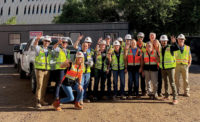$250,000. $1.5 million. $12 million. These are the litigation damage estimates that plaintiffs sought to recover against design professionals who failed to familiarize themselves with local site conditions.
For firms designing projects for clients with a regional, national or even international footprint, associating with local professionals is an often overlooked but necessary protection against embarrassing and costly design problems. The following are real-life case studies.
An East Coast-based engineering firm did not take expansive clay soils into consideration when it designed an under-slab sewer system. Detailing installation of PVC pipes into shallow, below-slab trenches had been the norm for the client’s warehouses throughout North America, so much so that boilerplate details were often passed from project to project without any serious scrutiny from the engineer who stamped the plans. While the firm had engineers licensed throughout the country, those engineers seldom had experience designing in every state where licenses were held.
Within a year of project completion, surface drainage found its way under the slab, wetting the subsurface soils. The resulting expansion of the clay split and shattered the PVC pipes. It was a multimillion-dollar design error.
In another example, a West Coast designer specified the make and model of a natural gas-burning fireplace to be installed in Colorado without realizing that the specified firebox was not rated for installation at altitudes above 3,500 ft and that the property had no access to a municipal gas service line. An above-ground propane tank was installed.
Gaseous propane is heavier than air, whereas natural gas is lighter. Natural gas burns slightly cooler than propane, so the orifice size on natural gas burning devices is larger compared with appliances that burn propane. The pressure of natural gas flowing through a service line is less than the pressure of gas in a propane tank. Within a week of completing the new home, the owner was delighted with 2-ft-tall flames in her fireplace. She recalled seeing a red glow at the top of the firebox that lasted for several minutes after she turned off the unit. Unfortunately, using the wrong orifice size and wrong fuel ignited the framing and insulation surrounding the firebox. The fire spread to the attic, setting off the sprinklers, which irreparably damaged several expensive works of art.
A final example involves an MEP designer that specified a natural gas heater and blower system for a homebuilder who was beginning to construct communities in states well above sea level. The designer failed to consider that as elevation rises, air density decreases, and with decreased density, heating and cooling efficiency ratings also decrease. A furnace rated at 80% efficiency is only 60% efficient at higher altitudes.Among the chief complaints from the new homeowners were cold spots that could not be attributed to insufficient insulation, leaving the homeowners with heating bills well above that predicted by the product literature and labels.
Even though most states have open reciprocity allowing a licensed engineer or architect to pay a fee to stamp plans in that jurisdiction, the licensing application process rarely, if ever, educates the design professional on nuanced design considerations for that jurisdiction. Make certain your team is prepared and protected by contacting the local building authority to learn about important conditions.



Post a comment to this article
Report Abusive Comment